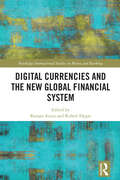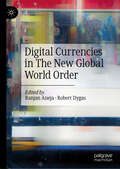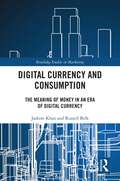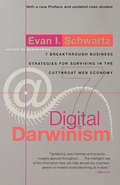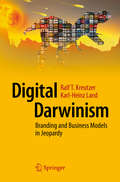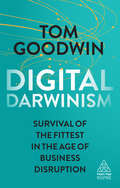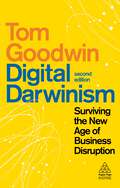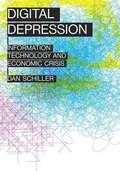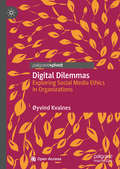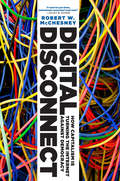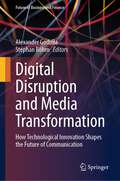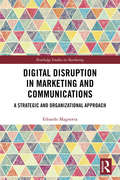- Table View
- List View
Digital Cultural Transformation: Building Strategic Mindsets via Digital Sociology (Innovation, Technology, and Knowledge Management)
by Donatella PaduaThe hypercomplex digital-technological environment is exponential and revolutionary. Our social mindset adaptation, instead, is slower and evolutionary, as an individual’s or an organization culture needs time to transform. This book offers students, institutions, and organisations innovative and interdisciplinary digital sociology tools to help build an adaptive, flexible, imaginative social mindset in order to cope with such a gap and to match a sustainable digital transformation (DT). By disrupting traditional linear approaches to understand the context into which business models are designed, institutions and students are challenged with innovative transdisciplinary holistic models grounded into business case studies. If the book stimulates students to learn how purposefully and autonomously to explore the web, to grasp the deeper meaning of DT and its social impact, institutions are solicited to answer to direct quests that go right to the core of their transformative DNA as: ‘How effectively are you carrying on DT in a sustainable, people-centred way? Which is your socio-cultural DT profile and what are your DT areas of strength and areas of improvement?'In this frame of work, the innovative Four Paradigm Model indicates new coordinates and provides original tools to profile an institution’s digital transformation strategy, to analyse it, and measure the level of sustainable socio-economic value. Sample syllabi, PowerPoint slides and quizzes are available online to assist in the teaching experience.
Digital Currencies and the New Global Financial System (Routledge International Studies in Money and Banking)
by Robert Dygas Ranjan AnejaThis book analyses the current debate around Central Bank Digital Currencies (CBDC) and the future of New Global Financial System. It offers deep insight into the global monetary policy in the context of digital and cryptocurrencies and examines both the opportunities and challenges to come. The book draws a clear distinction between digital and cryptocurrencies and answers several research questions, such as what the consequences of forming Central Bank Digital Currencies and their impact on the financial markets, in both advanced and developing economies, might be. Another question refers to whether the role of monetary policy easing has led to the rise of the virtual currency market, while still others relate to the impact of the pandemic on international settlements. The book also discusses the issue of investment in cryptocurrencies, and the related risks, whether or not this is a profitable investment vehicle, and how the digital banking system evaluates such investments. Further, the book also highlights the post-pandemic challenges for central banks, such as future monetary policy. It includes a complex review of the literature and presents elaborate econometric models of digital currencies and cryptocurrencies. The book has a wide geographic focus, examining these aspects from the perspective of several countries including China, India and the US. The primary audience for the book is researchers, scholars and students of international finance and economics but it will also appeal to practitioners concerned with the digitalisation of financial systems, policymakers and regulatory agencies.
Digital Currencies in The New Global World Order
by Robert Dygas Ranjan AnejaThis book explains the strong push for the security of digital currencies and the sustainability of global trade development. It studies multilateral international trade agreements such as Regional Comprehensive Economic Partnership Agreement. This book analyses and examines case studies from Asia and Europe presented from different trade agreements’ policies. It focuses on the role of digital currencies as the tool for global trade development used by the biggest economies and international trade organisations such as WTO. It explores the strategies of the respective countries using digital currencies in international trade to gain economic advantage. It is beneficial for international finance students and professionals working in the banking sector.
Digital Currency and Consumption: The Meaning of Money in an Era of Digital Currency (Routledge Studies in Marketing)
by Jashim Khan Russell BelkThe digitalization of payment modes, combined with the development of Blockchain technology, is shaping the future of digital currency worldwide. Many financial regulators are experimenting with the feasibility of digital currencies nationally in a variety of forms, such as cryptocurrency, virtual currency and central bank digital currency. These digital currencies are just some of those discussed in this book. Each facilitates a transaction efficiently and will likely open an alternative payment system, possibly leading to a global digital currency.This book will present and highlight a broad view of digital currency in the era of globalization. This book will address the meaning of money in a global world. By going beyond fungible national fiat-based currencies to global cryptocurrency and stablecoins, virtual currencies promise to disintermediate and decentralize money. The digital currencies that are the focus of this book use the internet for transactions and harbor the potential to make a unified digital currency system across the globe. This book explores the role of digital currency in influencing consumer behavior, from spending or saving to gaming, tipping and gambling. It asks what is the future of digital currency and what is its role in facilitating and transforming the future of the metaverse?Digital Currency and Consumption will be useful reading for a postgraduate audience to understand how digital currencies are shaping the digitalization of transactions and behavior of consumer citizens. It will be of value to researchers interested in a wide variety of disciplines, including international business, finance and consumer behavior.
Digital Customer Experience Engineering: Strategies for Creating Effective Digital Experiences
by Lars WiedenhoeferCustomer experience engineering applied to the engineering department is rare, but needed. Most companies keep support, UX, engineering, product, and CX separate. To address this gap, this book highlights roles and techniques that are proven to accelerate issue detection and prevention by 30% or more. With the author's vast experience in tech support, he has developed techniques and skills that allow engineers to gain customer insights faster and through new and insightful sources that are within their reach. You will develop a deep understanding of the impact of issues; understand and optimize the speed of the engineering feedback loop (issue resolution time); and develop the ability to calculate the cost of the issues or customer friction to the business (in aggregate and on a case-by-case basis). Organizations can save significant money and add additional revenue by addressing customer friction proactively in collaboration with product, engineering, and site reliability engineering (SRE) functions and reduce the average time of an issue resolution by 80%. The cross-functional leadership, mentoring, and engineering techniques you’ll learn from this proactive stance are very valuable and teachable, and this book will show you the path forward.What You Will LearnGain the techniques and tools necessary to validate customer journey success in productionContribute to customer-centric key performance indicators (KPIs) on executive dashboardsCreate meaningful insights and data points that allowed the feedback loop to be optimized and efficient Who This Book is ForProfessionals participating in the value stream of digital software engineering for the benefit of customer experiences, directly or indirectly. You may be an engineer practicing DevOps or site reliability, or you might be a product owner, UX designer, or researcher. You might be working in support and seeking for new ways to engage with your engineering teams.
Digital Customer Experience Management der Plattform Steam: HMD Best Paper Award 2017 (essentials)
by Benjamin SpottkeIm Zuge der Digitalisierung werden Gestaltung und Management der Digital Customer Experience zunehmend wertvoller. Technologieführer diverser Branchen sind besonders dafür bekannt, digitale Interaktionen zwischen Nutzern, Drittanbietern und weiteren Akteuren erfolgreich zu organisieren. In diesem essential wird die Videospieleplattform Steam mit der Fallstudienmethode untersucht. Basierend auf der Analyse von Steam werden Handlungsempfehlungen abgeleitet, die auch für Unternehmen in traditionellen Branchen anwendbar sind. Schwerpunkte bilden hierbei die Orientierung von Services und Serviceportfolio an Kundenbedürfnissen, das Management von Konsumententechnologie sowie die Entwicklung von Vertrauen und Loyalität durch Verankerung von Werten und Normen auf einer digitalen Plattform. Die Handlungsempfehlungen werden anschließend in der Automobilbranche, bei TV-Streaminganbietern und anhand einer Plattform für Autoreparaturen beispielhaft illustriert.Der AutorBenjamin Spottke lehrt und forscht am Institut für Wirtschaftsinformatik der Universität St. Gallen.
Digital Customer Experience: Mit digitalen Diensten Kunden gewinnen und halten (Edition HMD)
by Christoph Lattemann Susanne Robra-BissantzDie Digital Customer Experience rückt zunehmend in den Fokus, wenn es darum geht, Kunden einen besonderen Nutzen und ein besonderes Erlebnis zu versprechen, sie zufrieden zu stellen und zu binden. Sie ergänzt Produkte und Dienstleistungen und bietet dabei insbesondere im Kontakt zwischen Kunden und Anbietern digitale Services und Unterstützungsangebote. Hier setzt das Buch an: Der vorliegende Herausgeberband legt aus der theoretischen Perspektive der Service Dominant Logic die Grundlagen für die Betrachtung und Gestaltung einer Digital Customer Experience. Anschließend fokussieren die Autoren auf IT-gestützte Möglichkeiten, die persönliche Beziehung zwischen Kunde und Anbieter im stationären Einzelhandel durch digitale Dienste zu ergänzen. Besondere Betrachtungen einer mobilen oder mithilfe von virtueller Realität gestalteter Customer Experience sowie sozialer und kooperativer Konzepte schließen sich an. Ansätze zu Design und Rahmenbedingungen der Gestaltung einer Digital Customer Experience runden das Herausgeberwerk ab.Wie typisch für die Fachbuchreihe Edition HMD greifen die Beitragsautoren das Thema aus Sicht von Forschung und Praxis gleichermaßen auf.
Digital Customer Service: Transforming Customer Experience for an On-Screen World
by Rick DeLisi Dan MichaeliDigital Customer Service is the new standard for creating a 5-star customer experience As much as technology has improved our lives, for many people customer service experiences remain unnecessarily frustrating. But the advent of Digital Customer Service (DCS) promises to make these interactions seamless and effortless by creating experiences that occur entirely on a customer's own screen, even in situations where it is preferable to speak to an agent. Digital Customer Service: Transforming Customer Experience for an On-Screen World traces the evolution of customer service—as well as the evolution of customer expectations and the underlying psychology that drives customer behavior - from the days of the first call centers in the 1980s all the way to today's digital world. Written for Customer Service and Customer Experience leaders as well as C-suite executives (CEOs, CFOs, CIOs), Digital Customer Service helps business leaders balance three critical priorities: Creating an excellent experience for customers that increases customer loyalty and profitability Driving down the cost of Customer Service/Support interactions, while increasing revenue through Sales interactions Moving quickly toward the goal of "digital transformation" We have discovered—in our research and our first-hand experience—that when companies commit to achieving true Digital Customer Service, they can make significant progress toward all three of these goals at once. Digital Customer Service provides the roadmap for how your company can get there. And when you do, who wins? EVERYONE.
Digital Customer Success: Why the Next Frontier of CS is Digital and How You Can Leverage it to Drive Durable Growth
by Nick Mehta Kellie CapoteAutomate your Customer Success efforts to reduce churn and increase profits In Digital Customer Success: The Next Frontier, a team of trailblazing Customer Success professionals and digital entrepreneurs delivers an insightful discussion of the next stage in Customer Success management. In the book, you'll discover how to design and deploy touchless and automated digital interventions that help your software users learn and grow as they use your product and unlock the value trapped within it — without ever needing to reach out to a live Customer Success Manager. The authors provide a detailed “How-To” guide to Digital Customer Success that explains how you can meet the needs of your customers, investors, and team members. You'll explore the basics of the authors' original Digital Customer Success Maturity Model and the core tenets of how to get started. After that, you'll find: Explanations of the ideal organizational structures to enable Digital Customer Success management Case studies and examples from real companies blazing new trails in Customer Success Critical success measurements and metrics you can use to determine if your company is on the right track or if it needs to reorient Perfect for managers, executives, directors, founders, entrepreneurs, and other business leaders involved in the sale of digital and software products, Digital Customer Success is also a can't-miss resource for Customer Success professionals, sales leaders, marketers, product development professionals, and anyone else with a stake in reducing customer churn and increasing revenues.
Digital Darwinism
by Evan I. SchwartzDon't let the rapid evolution of the Internet economy leave your business extinct before its time. Here are the seven key strategies you need to keep your company alive, growing, and profitable. The world of Web commerce is today's fastest changing business landscape--and companies that thrive in this cutthroat economic arena need to be smarter, faster, more innovative, and more adaptable than ever before. Natural selection is already occurring, weeding out the start-ups and online ventures that fail to keep pace with evolving technology and customer needs. InDigital Darwinism, Evan I. Schwartz provides an unprecedented look inside the highly competitive world of e-commerce, and distills seven critical strategies that Web-based businesses need to follow in order to survive in what is fast becoming a multi-trillion-dollar online marketplace. Using entertaining, in-depth case studies of companies that have used surprising strategies to win customer loyalty and turn a profit, Schwartz explores why Web-based businesses succeed or fail and shows why more traditional businesses need to evolve along with the Web--or risk going the way of the dinosaurs. Drawing lessons from well-known consumer ventures such as Priceline and E*Trade, as well as business-to-business start-ups such as Instill and Band-X, Schwartz defines the pressing issues for all companies, such as online branding, creating the best package deals for your customers, making the most of your marketing affiliates, and--most importantly--how to integrate Web commerce into every aspect of your business. His seven strategies give you the nuts-and-bolts information you need to grow and stay one step ahead of the competition, whether you're launching a new Web-based venture, retooling a global enterprise, or simply looking for creative ways to supplement an existing business online. With its cutting-edge analysis and concrete advice--including a series of "Executive Survival Guides"--Digital Darwinismis a must-have resource for anyone, from novice entrepreneur to corporate CEO, who hopes to succeed in the new Web economy.
Digital Darwinism
by Ralf T. Kreutzer Karl-Heinz LandDigital Darwinism is a key challenge for all companies and brands. Not all companies and managers are aware of the challenges lying ahead. This book helps to identify the need for change and adaption based on a framework of findings and additional tools to position you and your company in the digital rat race.
Digital Darwinism: Survival of the Fittest in the Age of Business Disruption (Kogan Page Inspire)
by Tom GoodwinDigital Darwinism takes an exhilarating look at disruptive thinking to inspire those who want to be the best at digital transformation. Change across business is accelerating, but the lifespan of companies is decreasing. Life is more unpredictable than ever and leaders are facing a growing abundance of decisions to make, data to process and technology that threatens to disrupt even the most established business models. These are the forces that could destroy your company but, with the right strategy in place, they could also help you transform it into a market leader. Digital Darwinism is a guiding hand through the turbulence of this moment, offering practical strategies as well as an ambitious call-to-action that lights a fire underneath complacency and inspires creative change. In this book, Tom Goodwin shines a light into the future by exploring technology, society and the lessons of the past so that you can understand how to adapt, what to embrace and what to ignore. Goodwin proves how every assumption the business world has previously made about "digital" is wrong in order to revolutionize your mindset: incremental change isn't good enough, adding technology at the edges won't work and digital isn't a thing - it's everything. If you want your organization to succeed in the post-digital age, you need to be enlightened by Digital Darwinism.
Digital Darwinism: Surviving the New Age of Business Disruption (Kogan Page Inspire)
by Tom GoodwinDisruption is back with a vengeance. If ever there was a time to learn how to adapt, grab opportunities and bounce back - it's now. Learn how to keep your business relevant, meet new customer expectations and leverage technology.Bestselling author and business influencer Tom Goodwin is back with this entirely revised new edition of Digital Darwinism. This book guides you through the unrelenting pace of change and uncertainty facing business leaders today. Currently in a hybrid world where digital and real-world experiences collide and are expected to seamlessly blend into one another, never has the need to be on top of your digital transformation been felt more strongly. With new expectations from customers and employees alike, how will your business grow and survive the future? Learn how to become truly customer-centric, drive digital transformation through a culture of real innovation and challenge assumptions of how things have been done before. The survival of your business depends on it.
Digital Dawn in Adland: Transforming Australian Agencies (Routledge Studies in the History of Marketing)
by Robert CrawfordDrawing on a unique study of Australian advertising agencies at the dawn of the digital era, this book provides a hitherto unexplored study of the advertising industry at a point of its disruption. By exploring the dynamic interaction between this established but complacent industry, and a radically new communication medium, this book reveals how advertising agencies were forced to change fundamentally, yet as an industry helped shape the digital economy, and the platforms that dominate it. Based on contemporary reports, company archives, personal archives, and over 50 interviews with past and current advertising practitioners across the range of agency departments, this unique historical narrative reveals how power shifts between agencies, advertisers, and other media platforms forged the current models of advertiser-funded digital media. For scholars of marketing, media, communication, and contemporary history, this is an illuminating perspective on the early impact of the digital revolution and its relevance to the media landscape today.
Digital Decarbonization: Achieving climate targets with a technology-neutral approach
by Thomas Kaiser Oliver D. Doleski Michael Metzger Stefan Niessen Sebastian ThiemDecarbonization through optimized energy flows. In this book you will learn how a significant reduction in climate changing greenhouse gas emissions can be achieved through systemic optimization of our energy systems. The authors clearly demonstrate how energy-intensive processes can be optimized flexibly by using technology-neutral simulation methods to ensure that significantly fewer greenhouse gases are emitted.Such field-tested, data-based energy models described in this publication prove that "digital decarbonization" enables an economy that releases significantly fewer climate changing emissions while maintaining its production output. This is a promising message in view of ongoing climate change.
Digital Depression: Information Technology and Economic Crisis (The Geopolitics of Information)
by Dan SchillerThe financial crisis of 2007-08 shook the idea that advanced information and communications technologies (ICTs) as solely a source of economic rejuvenation and uplift, instead introducing the world to the once-unthinkable idea of a technological revolution wrapped inside an economic collapse. In Digital Depression, Dan Schiller delves into the ways networked systems and ICTs have transformed global capitalism during the so-called Great Recession. He focuses on capitalism's crisis tendencies to confront the contradictory matrix of a technological revolution and economic stagnation making up the current political economy and demonstrates digital technology's central role in the global political economy. As he shows, the forces at the core of capitalism--exploitation, commodification, and inequality--are ongoing and accelerating within the networked political economy.
Digital Designs for Money, Markets, and Social Dilemmas (Evolutionary Economics and Social Complexity Science #28)
by Yuji ArukaAn innovative feature of this book is its econocentric structure, focusing on digital designs. From the outset, econocentrism is assumed to be a core engine of capitalism, like money. The new coronavirus pandemic has changed lifestyles worldwide, which are unlikely ever to return in their original form. This great transformation will change the nature of the socio-economic system itself and will be centered on digital designs. At present, money already is beginning to undergo a major revolution in that sense. Many books dealing with digital designs and innovations have been published, but few if any of them focus on monetary and analytical methods in the way that this present volume does.The book then contains 6 parts: Evolution of money and thinking complexities in the AI era; Goods market and the future of labor market; Computational social approaches to social dilemmas, smart city, cryptocurrencies; Artificial market experiments; The randomness and high frequencies in financial data; Other trading strategy issues and the effects of AI usage. These issues may be indispensable subjects in our age. Study these subject, and have a step forward to the future society!
Digital Detox im Arbeitsleben: Methoden und Empfehlungen für einen gesunden Einsatz von Technologien (essentials)
by Christian Schmidkonz Patricia Kraft Viktoria WelleditsDie Digitalisierung verändert Alltag und Berufsleben: Laptops und Smartphones ermöglichen eine ständige Erreichbarkeit, die Grenzen zwischen Beruf und Alltag verschwinden, flexiblere Arbeitszeitmodelle sind möglich. Gleichzeitig steigt der digital ausgelöste Stress am Arbeitsplatz. Die digitale Überlastung schränkt die Produktivität ein und kann negative gesundheitliche Folgen haben. Digital Detox – der komplette Verzicht auf elektronische Geräte für einen gewissen Zeitraum – gewinnt an Bedeutung. Dieses Buch zeigt prägnant und leicht verständlich die Ursachen digitaler Abhängigkeit auf. Es diskutiert Methoden für einen gesunden Einsatz von Technologien und gibt konkrete Empfehlungen im Rahmen von Digital-Detox-Strategien.
Digital Development of the European Union: An Interdisciplinary Perspective
by Tanel Kerikmäe Ondrej Hamuľák David Ramiro TroitiñoThis edited volume analyses the digital development of the European Union, presenting an interdisciplinary perspective from the disciplines of political science, international relations, economics, and law. The contributions address the main areas where the EU can, and should act, for creating an efficient and protective digital space in Europe. The book highlights the responsibility of the European Union to work on the future of its digital development, looking for prosperity and defending the European conception of society. It explains how European values must be incorporated into the digital revolution and shows how the digital revolution of the EU will defend the Europeans from new threats. The book's comprehensive approach allows the reader to understand this process without in-depth knowledge of the specific discipline. Therefore, it is a must-read for everybody interested in a better understanding of digital development, European Union policy, and the future of Europe.
Digital Dilemmas: Exploring Social Media Ethics in Organizations
by Øyvind KvalnesSocial media is at the core of digital transformations in organizations. Facebook, Twitter, LinkedIn, and other social media platforms widen the scope for rapid and effective communication with stakeholders. They also create a range of new and challenging ethical dilemmas.This open access book categorizes the dilemmas organizations across a range of industries can face when they implement social media to communicate with stakeholders. This book provides a systematic framework for analyzing these ethical dilemmas in social media using the Navigation Wheel. This tool leads the decision-maker through a series of considerations such as legal questions, corporate identity, morality, reputation, and ethics. Finally, the author considers implications for leaders and presents potential solutions to these dilemmas. Based on five years of original research with 250 executive students at a European business school, all of whom work with social media communications in their organizations, this book is the first major study to explore the ethical use of social media across industries and is a valuable resource for researchers and practitioners alike.
Digital Disciplines
by Joe WeinmanLeverage digital technologies to achieve competitive advantage through better processes, products, customer relationships and innovation How does Information Technology enable competitive advantage? Digital Disciplines details four strategies that exploit today's digital technologies to create unparalleled customer value. Using non-technical language, this book describes the blueprints that any company, large or small, can use to gain or retain market leadership, based on insights derived from examining modern digital giants such as Amazon and Netflix as well as established firms such as GE, Nike, and UPS. Companies can develop a competitive edge through four digital disciplines--information excellence, solution leadership, collective intimacy, and accelerated innovation--that exploit cloud computing, big data and analytics, mobile and wireline networks, social media, and the Internet of Things. These four disciplines represent the extension and evolution of the value disciplines of operational excellence, product leadership, and customer intimacy originally defined by Michael Treacy and Fred Wiersema in their bestselling business classic The Discipline of Market Leaders. Operational excellence must now encompass information excellence--leveraging automation, information, analytics, and sophisticated algorithms to make processes faster, better, and more cost-effective, as well as to generate new revenue Product leadership must be extended to solution leadership--smart digital products ranging from wind turbines to wearables connected to each other, cloud services, social networks, and partner ecosystems Customer intimacy is evolving to collective intimacy--as face-to-face relationships not only go online, but are collectively analyzed to provide individually targeted recommendations ranging from books and movies to patient-specific therapies Traditional innovation is no longer enough--accelerated innovation goes beyond open innovation to exploit crowdsourcing, idea markets, challenges, and contest economics to dramatically improve processes, products, and relationships This book provides a strategy framework, empirical data, case studies, deep insights, and pragmatic steps for any enterprise to follow and attain market leadership in today's digital era. Digital Disciplines can be exploited by existing firms or start-ups to disrupt established ways of doing business through innovative, digitally enabled value propositionsto win in competitive markets in today's digital era.
Digital Disconnect
by Robert W. McchesneyCelebrants and skeptics alike have produced valuable analyses of the Internet's effect on us and our world, oscillating between utopian bliss and dystopian hell. But according to Robert W. McChesney, arguments on both sides fail to address the relationship between economic power and the digital world.McChesney's award-winning Rich Media, Poor Democracy skewered the assumption that a society drenched in commercial information is a democratic one. In Digital Disconnect McChesney returns to this provocative thesis in light of the advances of the digital age, incorporating capitalism into the heart of his analysis. He argues that the sharp decline in the enforcement of antitrust violations, the increase in patents on digital technology and proprietary systems, and other policies and massive indirect subsidies have made the Internet a place of numbing commercialism. A small handful of monopolies now dominate the political economy, from Google, which garners an astonishing 97 percent share of the mobile search market, to Microsoft, whose operating system is used by over 90 percent of the world's computers. This capitalistic colonization of the Internet has spurred the collapse of credible journalism, and made the Internet an unparalleled apparatus for government and corporate surveillance, and a disturbingly anti-democratic force.In Digital Disconnect Robert McChesney offers a groundbreaking analysis and critique of the Internet, urging us to reclaim the democratizing potential of the digital revolution while we still can.
Digital Disruption and Media Transformation: How Technological Innovation Shapes the Future of Communication (Future of Business and Finance)
by Alexander Godulla Stephan BöhmThis book presents a comprehensive compilation of the latest research into digital disruption in the media industry. The perspectives are differentiated into innovation triggers in the media industry stemming from the economy, society and technology. In addition, the book highlights selected case studies exploring new media actors and usage, innovation and disruption in media organizations, emerging media platforms and channels, as well as innovative media topics and events. The book is intended for researchers in communication sciences and media research, as well as media practitioners who want to understand the causes and effects of digital transformation in the media industry.
Digital Disruption and Transformation: Case Studies, Approaches, and Tools (Springer Proceedings in Business and Economics)
by Daniel Schallmo Frank Gertsen Abayomi Baiyere Claus Andreas Foss Rosenstand Christopher A. WilliamsIn an era marked by relentless digital disruption, where every interaction - whether it's a click, a tap, or a swipe - shapes the structure of our interconnected world, the need for transformative action becomes notably clear. This collection brings together a dynamic compilation of insights, carefully selected from leading experts in the field, ready to navigate the uncharted waters of this digital revolution. The collection comprises submissions from two ISPIM (International Society for Professional Innovation Management) events, along with additional contributions. It offers an extensive view that encompasses the various challenges and opportunities brought about by the tumultuous waves of digital disruption and transformation, spanning a wide range of aspects in contemporary business and society. The primary aim of this collection is to emphasize the idea that the emerging global digital economy urgently requires a comprehensive perspective on digitalization, making it central for all institutions. Contributions in this collection shed light on important subjects, including, but not limited to, The Evolution of Digital Transformation, Skills and Knowledge Requirements in the Era of Digital Transformations, and Data-Driven Foresight. Within the boundaries of this scholarly endeavor, a deep understanding of the intricate network of digitalization and its consequences is nurtured. As the relentless surge of digitalization continues, this collection serves as an invaluable guide for discerning scholars and practitioners alike, inviting them to navigate this transformative period with wisdom and expertise.
Digital Disruption in Marketing and Communications: A Strategic and Organizational Approach (Routledge Studies in Marketing)
by Edoardo MagnottaThis book sets out the new frontier of marketing and communication through real case histories. Companies must rethink their traditional approaches to successfully face the upcoming challenges. They must learn how to innovate and change things when they go well. New emerging technologies such as AI and IoT are the new frontiers of the digital transformation that are radically changing the way consumers and companies communicate and engage with each other. Marketing makes a company a change-maker, while communications tell the story to engage customers and stakeholders. The book introduces brand positioning (to match brand values and consumers’ attributes), and brand as human being (to raise trust, loyalty and engagement among customers and stakeholders), through Enel X and its partnership with Formula E in the e-mobility case, and the PMI case (its disruptive effect on tobacco industry). After a deep analysis of the disruptive effects on business models of the digital transformation, the book explores digital communications through the Pietro Coricelli case (how a well-designed digital strategy can raise reputation and sales). The book also provides a new holistic approach and identifies a future leader, through the H-FARM case (how to disrupt business models and education). The book is aimed at researchers, students and practitioners, and provides an improved understanding of marketing and communications, and the evolution of the strategic, organisational, and behavioural model.

